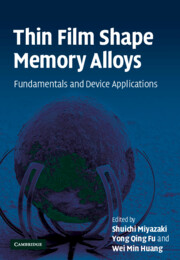Book contents
- Frontmatter
- Contents
- List of contributors
- Preface
- Abstracts of chapters
- 1 Overview of sputter-deposited TiNi based thin films
- 2 Martensitic transformation in TiNi alloys
- 3 Deposition techniques for TiNi thin film
- 4 TiNi multilayer thin films
- 5 Crystallization and microstructural development
- 6 Mechanical properties of TiNi thin films
- 7 Stress and surface morphology evolution
- 8 Ion implantation processing and associated irradiation effects
- 9 Laser post-annealing and theory
- 10 Overview of thin film shape memory alloy applications
- 11 Theory of SMA thin films for microactuators and micropumps
- 12 Binary and ternary alloy film diaphragm microactuators
- 13 TiNi thin film devices
- 14 Shape memory microvalves
- 15 Superelastic thin films and applications for medical devices
- 16 Fabrication and characterization of sputter-deposited TiNi superelastic microtubes
- 17 Thin film shape memory microcage for biological applications
- 18 Shape memory thin film composite microactuators
- 19 TiNi thin film shape memory alloys for optical sensing applications
- Index
3 - Deposition techniques for TiNi thin film
Published online by Cambridge University Press: 23 February 2010
- Frontmatter
- Contents
- List of contributors
- Preface
- Abstracts of chapters
- 1 Overview of sputter-deposited TiNi based thin films
- 2 Martensitic transformation in TiNi alloys
- 3 Deposition techniques for TiNi thin film
- 4 TiNi multilayer thin films
- 5 Crystallization and microstructural development
- 6 Mechanical properties of TiNi thin films
- 7 Stress and surface morphology evolution
- 8 Ion implantation processing and associated irradiation effects
- 9 Laser post-annealing and theory
- 10 Overview of thin film shape memory alloy applications
- 11 Theory of SMA thin films for microactuators and micropumps
- 12 Binary and ternary alloy film diaphragm microactuators
- 13 TiNi thin film devices
- 14 Shape memory microvalves
- 15 Superelastic thin films and applications for medical devices
- 16 Fabrication and characterization of sputter-deposited TiNi superelastic microtubes
- 17 Thin film shape memory microcage for biological applications
- 18 Shape memory thin film composite microactuators
- 19 TiNi thin film shape memory alloys for optical sensing applications
- Index
Summary
Abstract
Direct current vacuum sputter deposition is the commonly used method of creating TiNi thin film. Polished silicon wafers are a preferred substrate. Limitations on composition and impurities are similar to those for bulk material. These limitations impose severe constraints on sputtering conditions for obtaining optimal performance of the resulting material. Obtaining material with desirable shape memory properties, uniform composition and uniform thickness requires understanding and control of the processes used. With sputter deposition it is possible to produce thin films with a range of transition temperatures from 173 K to 373 K. Superelastic thin film can be made without cold work. After deposition, photolithography and chemical etching are used to create shapes and combine thin film with other materials to produce microdevices. Producing thin film with shape memory properties is not difficult. But, to obtain uniformity and high yield requires specialized equipment and great care in process control. This chapter introduces some specific recommendations for fabrication of TiNi thin film and incorporation in useful devices. Applications of TiNi thin film are described elsewhere (see Chapter 10).
Introduction to methods of making TiNi thin film
Titanium nickel shape memory alloy (TiNi SMA) in the form of thin film has been available in limited quantities for nearly two decades [1, 2]. This chapter describes the technology and methods used in forming TiNi thin film and combining it with other materials to create useful microdevices from the perspective of TiNi Alloy Company personnel who have been involved in the development from some of the earliest efforts [3, 4, 5].
- Type
- Chapter
- Information
- Thin Film Shape Memory AlloysFundamentals and Device Applications, pp. 88 - 109Publisher: Cambridge University PressPrint publication year: 2009



